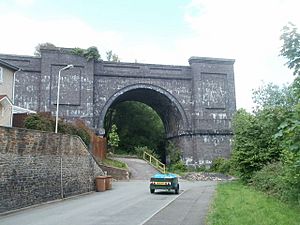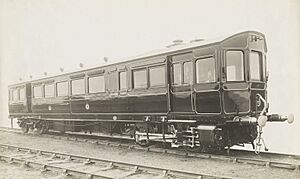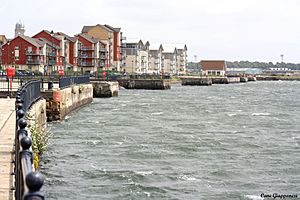Barry Railway Company facts for kids
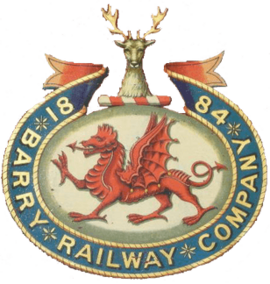 |
|
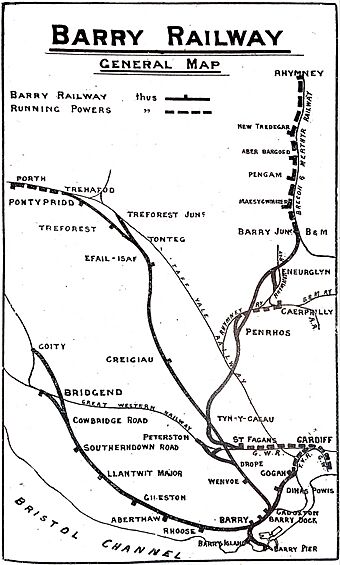
1920 map of the railway
|
|
| Technical | |
|---|---|
| Track gauge | 4 ft 8 1⁄2 in (1,435 mm) |
| Length | 67 miles 69 chains (109.2 km) (1919) |
| Track length | 309 miles 57 chains (498.4 km) (1919) |
The Barry Railway Company was a railway and docks company in South Wales. It started as the Barry Dock and Railway Company in 1884. It was created because coal owners in the Rhondda Valley were frustrated. They faced long delays and high costs at Cardiff Docks, and the Taff Vale Railway had a monopoly on moving their coal.
The Barry Railway opened its main line from Trehafod in the Rhondda to Barry in 1889. Its first dock opened the same year, with modern loading equipment. The railway was an instant success, mainly carrying coal. By 1910, Barry had become the biggest coal export point in South Wales. In 1913, it set a world record by shipping over 11 million tons of coal. Later, the company built expensive lines to connect with the Rhymney Railway and Brecon and Merthyr Tydfil Junction Railway.
Even though it mostly carried minerals, the Barry Railway also ran passenger trains from Barry to Cardiff. After 1918, the South Wales coal industry started to decline, and the Barry Railway suffered. In 1922, many railways joined together to form larger companies. The Barry Railway became part of the Great Western Railway. The Great Western Railway decided to simplify things. The main Barry line, which was similar to an existing Taff Vale line, was used less. Passenger service on parts of it ended in 1930, but freight continued until 1951. Today, the line from Barry to Cogan, near Penarth, is still busy with passenger trains to Cardiff and other valleys.
Contents
- Why a New Railway Was Needed
- Early Attempts to Build the Barry Railway
- The Barry Dock and Railway Company is Born
- Rivalry with the Taff Vale Railway
- First Openings and Success
- Company Name Change
- Expanding the Network
- Extensions at Barry
- Connecting to the Rhymney Railway
- Improvements at Cadoxton
- Reaching the Brecon and Merthyr Railway
- Financial Success
- Passenger Services
- After 1922: Joining the Great Western Railway
- Demolition of Viaducts
- Under British Railways and Today
- Topography
- Locomotives
- Rolling Stock
- Storage of Steam Locomotives
- Associated British Ports
- Steamers Owned by the Barry Railway
- Surviving Rolling Stock
Why a New Railway Was Needed
In the early 1800s, it was very important to find a good way to move coal and iron from the South Wales Valleys to the ports. Canals helped, but the Taff Vale Railway showed that trains were even better.
The Taff Vale Railway and Cardiff Docks were very successful. But as more coal was mined, traffic grew hugely. Cardiff Docks seemed to have a monopoly, meaning they had all the control. Coal ships often had to wait for days to load, and coal trains waited for hours to enter the docks.
To help with this, new parts were added to the docks. In 1865, a new harbor opened at Penarth with its own railway.
Early Attempts to Build the Barry Railway
| Barry Railway Act 1865 | |
|---|---|
| Act of Parliament | |

|
|
| Citation | 28 & 29 Vict. c. ccxxxiv |
In 1865, a "Barry Railway" was officially approved by an act of Parliament. It was meant to build a branch line from Peterston to Barry. Another act in 1866 allowed a harbor to be built at Barry.
However, both these plans failed. The Taff Vale Railway controlled most of the coal transport to Cardiff and didn't want competition. Also, a financial crisis made it impossible to get money for the projects.
The Barry Dock and Railway Company is Born
People were still unhappy with the existing railways and docks. They really wanted another option to break the monopoly. In 1882, some groups linked to the Taff Vale Railway and Cardiff Docks suggested new docks. They also said that coal transport costs would go up to pay for these new docks. This made the coal owners even angrier.
David Davies, a well-known railway builder and businessman, teamed up with others. They planned to build a new dock and railway system. They presented their idea to Parliament in 1883, but it was rejected because of strong opposition from the Taff Vale Railway and other companies.
| Barry Dock and Railways Act 1884 | |
|---|---|
| Act of Parliament | |

|
|
| Long title | An Act to authorise the Construction of a Dock at Barry Island and Railways and Works in Glamorganshire connected therewith and for other purposes. |
| Citation | 47 & 48 Vict. c. cclvii |
| Dates | |
| Royal assent | 14 August 1884 |
| Other legislation | |
| Repealed by | Vale of Glamorgan (Barry Harbour) Act 1978 |
|
Status: Repealed
|
|
| Text of statute as originally enacted | |
They tried again in 1884, and this time their plan was approved. The Barry Dock and Railways Act 1884 became law on August 14, 1884. The cost for getting these approvals was about £70,000, which was a huge amount of money back then.
The company was allowed to raise £1,050,000. They would build a railway from Barry north to Trehafod in the Rhondda. They also planned connections to the Great Western Railway and the Taff Vale line. The dock was planned to be 73 acres, the largest enclosed dock in the country. The area between Barry Island and the mainland would become a non-tidal dock, covering 200 acres.
Rivalry with the Taff Vale Railway
The Taff Vale Railway felt the impact of the new Barry developments. They didn't control the Cardiff Docks and had to follow the rules of the dock owners. The Barry Dock and Railway, however, would control both the railway and the docks, giving it a big advantage.
The Taff Vale tried to get permission to buy the Cardiff Docks in 1885, but this was refused. The Taff Vale also supported a new railway that would compete with Barry, but this was also rejected. Instead, the Barry company was allowed to build a railway from Barry to Cogan, connecting with the Taff Vale's lines.
This was a win for Barry. But it meant the Taff Vale Railway could still bring Rhondda coal to Barry using a coastal line, instead of handing it over to the Barry Railway at Trehafod. In 1888, Barry asked Parliament again for more access north of Trehafod. This was refused, but rules were put in place to ensure fair treatment.
First Openings and Success
On December 20, 1888, the line between Barry Dock and Cogan opened for local passenger trains. On the same day, the Taff Vale opened its coastal passenger service to Cadoxton, which later extended to Barry.
The main Barry Railway line took more effort to build. On May 13, 1889, the line from Barry to the Great Western Railway junctions at Peterston opened for goods and mineral trains. The Cogan line also started carrying these trains.
The dock was also getting ready. Water was let into it on June 29, 1889, and it officially opened on July 18, 1889. On that day, the main railway line from Trehafod and Treforest also opened for mineral trains.
The new railway and dock were an immediate success. Huge amounts of coal and other goods moved through them. This meant less business for the Taff Vale Railway and the Cardiff Docks. They lowered their prices to compete, starting a "rate war."
Company Name Change
| Barry Dock and Railways Act 1891 | |
|---|---|
| Act of Parliament | |

|
|
| Citation | 54 & 55 Vict. c. clxxxiv |
The company was first called the Barry Dock and Railway Company. It turned out that having "dock" first in the name was a disadvantage for its shares. So, they decided to change the name to The Barry Railway Company. This was approved on August 5, 1891.
Expanding the Network
The Barry directors soon thought about extending their railway to get more traffic from the Rhymney Valley. They tried to get approval in Parliament in 1888 and 1889, but these plans were withdrawn. However, they did get important agreements.
The Taff Vale Railway agreed to let Barry trains use their lines (except for passenger trains) between Cogan and Walnut Tree Junction. This gave Barry access to the Rhymney Railway. Barry also got permission to run all types of trains to Penarth Curve South Junction, where it connected to the Great Western Railway main line. From there, the GWR had a line into an important industrial area. Both Barry and Taff Vale could use this line for trains.
This allowed the Barry Railway to run passenger trains between Barry and Cardiff Riverside GWR station from August 14, 1893. The Taff Vale had already agreed to through tickets, as making passengers re-buy tickets at Cogan was unfair. So, Barry now had a good passenger service for people living in the area.
The passenger service was extended to Cardiff Clarence Road from April 2, 1894, with many trains running each weekday.
Extensions at Barry
It was clear from the start that Barry Docks would need to be bigger. So, in 1893, the Barry Railway Act 1893 allowed for a No. 2 Dock, covering 34 acres. The huge amount of trade meant the company also became responsible for managing the docks, including guiding ships and keeping order.
The 1893 Act also allowed for a railway extension to Barry Island. Barry was becoming a popular seaside holiday spot. At first, it was planned as a tramway, but this was changed to a regular railway branch the next year. The 3/4-mile long line was built quickly and opened on August 3, 1896.
Connecting to the Rhymney Railway
The Barry Railway had been able to reach the Rhymney Railway since 1891 by using the Taff Vale Railway. But as traffic grew, crossing the busy Taff Vale main line became difficult. If Barry could build a more direct connection, it could also link with the London and North Western Railway's line. This would open up a huge new route for goods between Cardiff and the West Midlands and North West England.
In 1896, the Barry Railway proposed building a new line from Tynycaeau Junction to join the Rhymney Railway near Caerphilly. They also wanted permission to use the Rhymney Railway's lines further north. The Barry Railway Act 1896 was passed on August 7, 1896, for the 7-mile line, but the permission to use other lines was refused.
The new line was very complex to build. It included the Walnut Tree Viaduct, which was 517 yards long. It finally opened on August 1, 1901, but only for goods and mineral trains. It cost £270,000.
Improvements at Cadoxton
The Barry Railway's mineral operations focused on the sidings at Barry and Cadoxton. Here, trains were sorted, and coal was stored while waiting for ships. About 100 miles of sidings were in this area, and getting trains into them caused serious traffic jams. In 1898-1899, a special "burrowing junction" was built at Cadoxton. This allowed trains to go under other lines to reach the docks, helping to ease congestion.
Reaching the Brecon and Merthyr Railway
Since they couldn't get full access to the Rhymney network, the Barry Railway decided to extend their new line further north-east. This would connect with the Brecon and Merthyr Tydfil Junction Railway, crossing the Rhymney Valley to do so.
The Barry Railway Act 1898 allowed this extension. The new line was 3.75 miles long and involved even bigger engineering challenges. One major project was the Llanbradach or Pwll-y-Pant viaduct. This viaduct alone cost about half of the £500,000 total for the line. It was 2,400 feet long with eleven spans, 125 feet above the valley floor.
This new route opened for goods and mineral traffic on January 2, 1905. Passenger excursion trains to Barry also used the line.
Financial Success
From the very beginning, the Barry Railway was incredibly successful financially. The amount of traffic, the number of ships at Barry, and the quantity of coal exported were all record-breaking. Shareholders usually received excellent dividends, often 10% in many years. Even when money was spent on new projects, the company remained very profitable.
Passenger Services
While coal traffic was the main business, the Barry Railway also ran a good passenger service. Between Barry and Cardiff, there were 33 trains each way every weekday. Services to Porth and Bridgend were less frequent.
In 1898, ten trains ran daily between Cardiff Riverside and Pontypridd. The company even tried using railmotors (single coaches with a small steam engine) from 1905. These were meant for simple stops with minimal facilities.
The Barry Railway bought two steam railmotors in 1905. They used them between Pontypridd and Cardiff. However, these railmotors struggled with hills and had problems with keeping time. The general manager decided to stop using them on this line from June 1, 1905. The railmotors were then used on other lines or converted into regular coaches.
After 1922: Joining the Great Western Railway
World War I changed things for the Barry Railway. The world's coal trade changed as ships started using oil instead of coal. Also, the government planned to reorganize all railways.
This led to the Railways Act 1921, which created four large railway companies. Most British railways had to join one of these "groups." The Barry Railway became part of the new Great Western Railway (GWR) on January 1, 1922. The Barry Railway was the fifth largest company to join the GWR.
The GWR made some changes to simplify operations. For example, GWR locomotives started running directly from the coal mines to Barry without needing to change engines. This was more efficient.
In 1929, major changes were made at Barry Island. Two new platforms were added for summer holiday trains. The government also offered money to railway companies for improvements that would help the public and create jobs.
The GWR used this money to improve Barry Dock. They built sixteen new coal hoists, which were massive structures. They also improved tracks and enlarged wagon turntables to handle new, larger wagons.
Near Treforest, the Barry line and another line ran close together. In 1930, the layout was redesigned. The Barry passenger station at Pontypridd was closed. Parts of the line were later used for wagon storage, and the through route was completely closed in June 1951.
Demolition of Viaducts
In 1937, the Pen-yr-Heol viaduct of the Barry Railway was taken down. Its main girders were 101 feet long and weighed about 35 tons each. They were tipped off the piers and fell 50 feet into the valley, where they were cut up for scrap.
Next, the larger Pwll-y-Pant viaduct, built in 1904, was demolished in 1937. It had 11 piers and sixteen spans. The main girders weighed about 90 tons each. The steel decking was burned off, and the girders were pushed off the piers to fall to the ground. The piers themselves were blown up with explosives in 1938.
Under British Railways and Today
In 1948, the Barry Railway network became state-owned as part of British Railways. In 1962, the British Transport Docks Board took over all major docks, including Barry.
Local passenger services between Barry and Pontypridd, and between Cardiff and Pontypridd, ended on September 10, 1962. Many parts of the old Barry Railway lines were closed in the early 1960s.
However, the Vale of Glamorgan Railway line, which had closed to passengers in 1964, was reopened on June 10, 2005. New stations were built at Llantwit Major and Rhoose (now called 'Rhoose Cardiff International Airport').
Today, Associated British Ports still uses the Barry Dock. The impressive old office building, which was the Barry Docks & Railway Co. headquarters, is still standing. It's a beautiful building with a clock tower and classical decorations. It's the only remaining example of the original Barry Railway buildings.
Parts of the former Barry Railway network are still in use as of 2021. The line between Cogan and Barry Island has a busy passenger service and some freight. The Vale of Glamorgan Branch (Barry–Bridgend) is used for both freight and passengers. This line is also important for diversions when the main line between Cardiff and Bridgend is closed.
Topography
Main Line Stations
- Hafod Junction; closed June 1951
- Pontypridd; opened 1896; closed 1930
- Treforest; opened 1898; closed 1930
- Efail Isaf; opened 1896; closed 1962
- Creigiau; opened 1896; closed 1962
- Wenvoe; opened 1896; closed 1962
- Cadoxton; opened 1888; still open
- Barry Dock[s]; opened 1888; still open
- Barry; opened 1889; still open
- Barry Island; opened 1896; still open
- Barry Pier; opened 1899; closed 1976
Cardiff Branch Stations
- Cogan; opened 1888; still open
- Eastbrook; opened 1986; still open
- Dinas Powis; opened 1888; still open
- Cadoxton; (see above)
Vale of Glamorgan Railway Stations
- Rhoose; opened 1897; closed 1964; reopened as Rhoose Cardiff International Airport in 2005; still open
- Aberthaw; opened 1897; closed 1964
- Gileston; opened 1897; closed 1964
- Llantwit Major; opened 1897; closed 1964; reopened 2005; still open
- Llandow Halt; opened 1915; closed 1964
- Southerndown Road; opened 1897; closed 1961
Tunnels
The Wenvoe tunnel is one of the longest railway tunnels in South Wales, at 1,867 yards. Traffic stopped using it on March 31, 1963.
Locomotives
The Barry Railway was a smaller company, so it bought its locomotives from private builders like Sharp, Stewart and Company. Like many railways in South Wales, it preferred locomotives with six or eight driving wheels.
By 1914, the company had 148 locomotives. When the railways were grouped in 1922, all Barry locomotives were renumbered into the Great Western Railway's system. Not a single Barry locomotive was scrapped while the company existed.
Rolling Stock
Coaching stock (passenger carriages) was painted a dark red color with 'straw' colored lines. The letters on the carriages were gold with shading.
Wagons were painted red-brown. They usually had large white "BR" letters and numbers on the side.
Storage of Steam Locomotives
In the 1960s, British Railways decided to stop using many steam locomotives. A company called Woodham Brothers bought many of these old engines and stored them in the dock sidings at Barry. They didn't scrap them right away because of changing metal prices. The site became famous as a "graveyard" for steam engines. Later, many of these locomotives were bought by groups who wanted to save them and restore them to working order.
Associated British Ports
When Britain's main railways became state-owned in 1948, most railway-owned docks also became part of British Railways.
In 1962, the British Transport Docks Board was created by the government to manage various ports that used to belong to the railway industry, including Barry. In 1983, this organization became a private company called Associated British Ports (ABP). ABP still owns and operates the docks today.
Steamers Owned by the Barry Railway
| Ship | Launched | Tonnage (GRT) | Notes |
|---|---|---|---|
| Barry | 1907 | 497 | Sold in 1910. Used as a minesweeper in First World War. Bombed in 1941. |
| Devonia | 1905 | 520 | Sold in 1910. Used as a minesweeper in First World War. Abandoned at Dunkirk in 1940. |
| Gwalia | 1905 | 562 | Sold in 1910. Used as a minesweeper in First World War. Bombed and sunk at Dunkirk in 1940. |
| Westonia | 1889 | 393 | Bought by Barry Railway in 1905. Sold in 1910. Scrapped in 1924. |
Surviving Rolling Stock
A few original Barry Railway coaches still exist today. Coach No. 15 is being restored at the Gwili Railway. No. 45 is stored with the National Museum of Wales. No. 71 is in Blakemere. Nos. 97 and 211, plus another coach, are now private homes.
Only two Barry Railway goods wagons are known to still exist. No. 1151 is at the Kent and East Sussex Railway. No. 1388 is at the Gloucestershire Warwickshire Railway.



